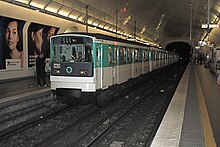Villiers (Paris Metro)
|
|
|
|---|---|

|
|
| Tariff zone | 1 |
| Line (s) |
|
| place | Paris VIII , XVII |
| opening | January 21, 1903 |
Villiers is an underground transfer station of the Paris Métro . It is served by lines 2 and 3 .
location
The metro station is located on the border of the Quartier de l'Europe in the 8th arrondissement with the Quartier de la Plaine-de-Monceaux in the 17th arrondissement of Paris . The stations of both lines are parallel to each other and lengthways under the Boulevard de Courcelles between the Avenue de Villiers and the Boulevard Malesherbes.
Surname
The subway station takes its name from the nearby avenue de Villiers. The village of Villiers was incorporated into Paris in 1860.
history
After the first extension of line 2 north from Étoile (since 1970: Charles de Gaulle - Étoile ) to Anvers had been put into operation on October 7, 1902, the station located there was opened on January 21, 1903, initially under the Name "Avenue de Villiers". On October 14, 1907, the addition "North" was dropped, and the line has only been number 2 since then.
The station on line 3 was opened on October 19, 1904. Initially it was planned to run the trains from there on over the routes of lines 2 north and 1 to Porte Maillot . Therefore, it was built at the same height next to the station on Line 2. The planning was changed during the construction work, as the lines were to be operated in one line from now on. In order to be able to pass under Line 2 during a later extension, the tracks and platforms were lowered, creating an unusually high hall. To the west of it, under Parc Monceau , an underground end loop was built that no longer exists.
For five and a half years the station remained the western terminus of line 3. On May 23, 1910, the line was extended by three stations to Pereire , Villiers thus also on this line to the through station.
In 2009 tiles and lighting were renewed.
description

Line 2 follows the Boulevard de Courcelles, which runs from east to west. Coming from the south-east on Rue de Constantiople, line 3 turns into it and leaves it again in a north-westerly direction under Boulevard Malesherbes.
The stations on both lines are each 75 m long. They lie parallel to each other under Boulevard de Courcelles, those of line 3 south of the station of line 2. The platforms of line 3 are, with the same ceiling level, a little lower, as the one to the west of the station system passes under line 2. Both stations have elliptical vaulted ceilings and side platforms on two parallel tracks. The ceilings and walls are tiled in white, the side walls of the station on Line 2 follow the curvature of the ellipse.
The station has two entrances, one of which is at the intersection of Boulevard de Courcelles and Boulevard Malesherbes - Avenue de Villiers. It is marked by a mast with a yellow “M” in your double circle and after 2006 it replaced a “broadcast transmitter” mast. The second entrance on the south side of the Boulevard de Courcelles was designed by Hector Guimard and is a listed building. There is also an additional exit with an escalator.
vehicles

Initially, trains made up of two-axle vehicles ran on Line 2 North. From 1914 to 1981 line 2 was used by Sprague-Thomson trains. Since it was not to be converted to vehicles with rubber tires in the medium term, the MF 67 series was launched in 1979 , completely replacing its predecessor within two years. Series MF 01 series vehicles have been used in the station of Line 2 since 2008 , now exclusively.
The first Métro vehicles with bogies ran on Line 3 from the start . It was also the first line of the Métro to receive the new MF 67 rolling stock between July 1968 and April 1971. The trains, which were renovated between 2005 and 2008, will continue to be in service there in 2020; from 2028 they are to be replaced by vehicles from the MF 19 series.
Others
The Musée Cernuschi is in the immediate vicinity of the train station .
Web links
literature
- Gérard Roland: Stations de métro. D'Abbesses à Wagram . 2003, ISBN 2-86253-307-6 .
Individual evidence
- ^ Gérard Roland: Stations de métro d'Abbesses à Wagram . Christine Bonneton, Clermont-Ferrand 2011, ISBN 978-2-86253-382-7 , pp. 211 .
- ^ Jean Tricoire: Un siècle de métro en 14 lignes. De Bienvenüe à Météor . 2nd Edition. La Vie du Rail, Paris 2000, ISBN 2-902808-87-9 , p. 150 .
- ^ A b Christoph Groneck: Metros in France . 1st edition. Robert Schwandl, Berlin 2006, ISBN 3-936573-13-1 , p. 16 .
- ↑ Jean Tricoire: op.cit. P. 162.
- ↑ Jean Tricoire: op.cit. P. 166.
- ^ Brian Hardy: Paris Metro Handbook . 3. Edition. Capital Transport Publishing, Harrow Weald 1999, ISBN 1-85414-212-7 , pp. 36 .
- ↑ Jean Tricoire: op.cit. P. 159.
- ↑ Jean Tricoire: op.cit. P. 154.
- ↑ Jean Tricoire: op.cit. P. 162.
- ↑ Jean Tricoire: op.cit. P. 104.
- ↑ Jean-Gabriel Bontinck: Métro: ligne par ligne, découvrez quand les nouvelles arriveront rames. In: Le Parisien . April 11, 2019, accessed June 7, 2020 (French).
| Previous station | Paris metro | Next station |
|---|---|---|
|
Monceau ← Porte Dauphine |
|
Rome Nation → |
|
Malesherbes ← Pont de Levallois - Bécon |
|
Europe Gallieni → |
Coordinates: 48 ° 52 ′ 52.9 " N , 2 ° 18 ′ 56.2" E


